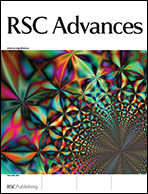Improved performance of microbial fuel cells using sulfonated polyether ether ketone (SPEEK) TiO2–SO3H nanocomposite membrane
Abstract
The microbial fuel cell (MFC) is a new technology for simultaneous electricity generation and wastewater treatment. An enhancement in the proton exchange membrane (PEM) of MFCs is essential for their scale-up and commercialization. In this work we demonstrate, for the first time, the use of sulfonated inorganic fillers in polyelectrolyte nanocomposite membranes as an effective approach to improve the MFC performance. A new nanocomposite membrane based on a sulfonated polyether ether ketone (SPEEK) hybrid with sulfonated TiO2 particles (TiO2–SO3H) was fabricated and evaluated in a microbial fuel cell. To authenticate the advantages of a SPEEK–TiO2–SO3H composite membrane, the IEC value, water uptake, proton conductivity, oxygen crossover, microbial fuel cell (MFC) performance and internal resistance were compared with a SPEEK–TiO2 membrane and a SPEEK membrane. The SPEEK–TiO2–SO3H membrane (7.5 wt%) exhibited the highest peak power density of 1202.5 mW m−2 compared with the power densities of 766 mW m−2 and 676 mW m−2 obtained for the SPEEK–TiO2 membrane and the SPEEK membrane, respectively, in the single chamber microbial fuel cell (SCMFC) membrane. The electrochemical behaviour of the membrane was improved by adding different amounts of TiO2–SO3H into the membrane to enhance the proton conductivity and also to reduce biofouling. Higher power was achieved with the 7.5 wt% TiO2–SO3H incorporated SPEEK–TiO2–SO3H membrane. In comparison to previously reported work with Nafion 117 (300 mW m−2) in MFCs, the composite membrane delivers a 4-fold higher power density. The oxygen mass transfer coefficient (KO) of the nanocomposite membranes decreased with incorporation of the sulfonated titanate in the nanocomposite membranes. The internal resistance for the SPEEK–TiO2–SO3H and SPEEK membranes were estimated to be 37 Ω and 74 Ω, respectively. The improved performance was attributed to the introduction of TiO2–SO3H particles, whose high proton conductivity and good water adsorbing/retaining function could facilitate effective proton transfer in the membrane. To the best of our knowledge, this new hybrid SPEEK–inorganic sulfonated nanocomposite is fabricated for the first time and applied to MFCs.


 Please wait while we load your content...
Please wait while we load your content...